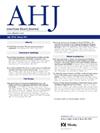High Medication Burden in Individuals With Difficult-to-Control Type 2 Diabetes: Clinical Characteristics From the CATALYST Study
IF 3.5
2区 医学
Q1 CARDIAC & CARDIOVASCULAR SYSTEMS
引用次数: 0
Abstract
CATALYST (NCT05772169) was the largest prospective study to date to assess the prevalence of hypercortisolism in individuals with difficult-to-control type 2 diabetes (T2D), finding a prevalence of 23.8% (n=252/1,057). With a participant cohort of >1,000, the study was uniquely positioned to explore demographic and clinical characteristics associated with difficult-to-control T2D. Here we describe the characteristics of the CATALYST Part 1 population. Individuals with hemoglobin A1c (HbA1c) 7.5–11.5%, despite taking multiple antihyperglycemic medications, were screened for hypercortisolism using the 1-mg overnight dexamethasone suppression test (DST). Those with known causes of false-positive DSTs were excluded. The study population had a mean age of 60.7 years, 45% were female, 71% were White, 19% were African American, and 24% were Hispanic/Latino. Mean HbA1c was 8.8%, and mean systolic blood pressure (SBP) was 127.6 mmHg. 31% had SBP ≥135 mm/Hg. 43% were taking ≥4 glucose-lowering medications, including sodium-glucose cotransporter 2 inhibitors (52%), glucagon-like peptide-1 receptor agonists (48%), and tirzepatide (10%). Antihypertensive medications were used by 82% of participants, with 27% taking ≥3 antihypertensives. Lipid-modifying medications (primarily statins) were used by 83%, psychiatric medication by 30%, and analgesic medications by 30% of participants. Cardiac disorders were present in 33% and 21% of participants and hypertension was present in 89% and 79% of participants with and without hypercortisolism, respectively. In summary, CATALYST participants had a high medication and comorbid disease burden, with T2D that remained difficult to control despite multiple glucose-lowering medications. In addition, many participants had elevated SBP despite extensive use of antihypertensive medications.
难以控制的2型糖尿病患者的高药物负担:来自CATALYST研究的临床特征
CATALYST (NCT05772169)是迄今为止评估难以控制的2型糖尿病(T2D)患者高皮质醇症患病率的最大前瞻性研究,发现患病率为23.8% (n=252/ 1057)。该研究纳入了1000名参与者,旨在探索与难以控制的T2D相关的人口学和临床特征。在这里,我们描述了CATALYST第1部分人口的特征。糖化血红蛋白(HbA1c)为7.5-11.5%的个体,尽管服用了多种降糖药物,但使用1毫克地塞米松抑制试验(DST)筛查高皮质醇血症。排除了已知DSTs假阳性原因的患者。研究人群的平均年龄为60.7岁,45%为女性,71%为白人,19%为非洲裔美国人,24%为西班牙裔/拉丁裔。平均HbA1c为8.8%,平均收缩压(SBP)为127.6 mmHg。31%的患者收缩压≥135 mm/Hg。43%的患者服用≥4种降糖药物,包括钠-葡萄糖共转运蛋白2抑制剂(52%)、胰高血糖素样肽-1受体激动剂(48%)和替西肽(10%)。82%的参与者使用抗高血压药物,27%服用≥3种抗高血压药物。83%的参与者使用降脂药物(主要是他汀类药物),30%的参与者使用精神药物,30%的参与者使用镇痛药物。33%和21%的参与者存在心脏疾病,89%和79%的参与者存在高血压,伴有和不伴有高皮质醇血症。总之,CATALYST参与者有很高的药物和合并症疾病负担,尽管使用多种降糖药物,T2D仍然难以控制。此外,尽管广泛使用抗高血压药物,许多参与者仍有升高的收缩压。
本文章由计算机程序翻译,如有差异,请以英文原文为准。
求助全文
约1分钟内获得全文
求助全文
来源期刊

American heart journal
医学-心血管系统
CiteScore
8.20
自引率
2.10%
发文量
214
审稿时长
38 days
期刊介绍:
The American Heart Journal will consider for publication suitable articles on topics pertaining to the broad discipline of cardiovascular disease. Our goal is to provide the reader primary investigation, scholarly review, and opinion concerning the practice of cardiovascular medicine. We especially encourage submission of 3 types of reports that are not frequently seen in cardiovascular journals: negative clinical studies, reports on study designs, and studies involving the organization of medical care. The Journal does not accept individual case reports or original articles involving bench laboratory or animal research.
 求助内容:
求助内容: 应助结果提醒方式:
应助结果提醒方式:


